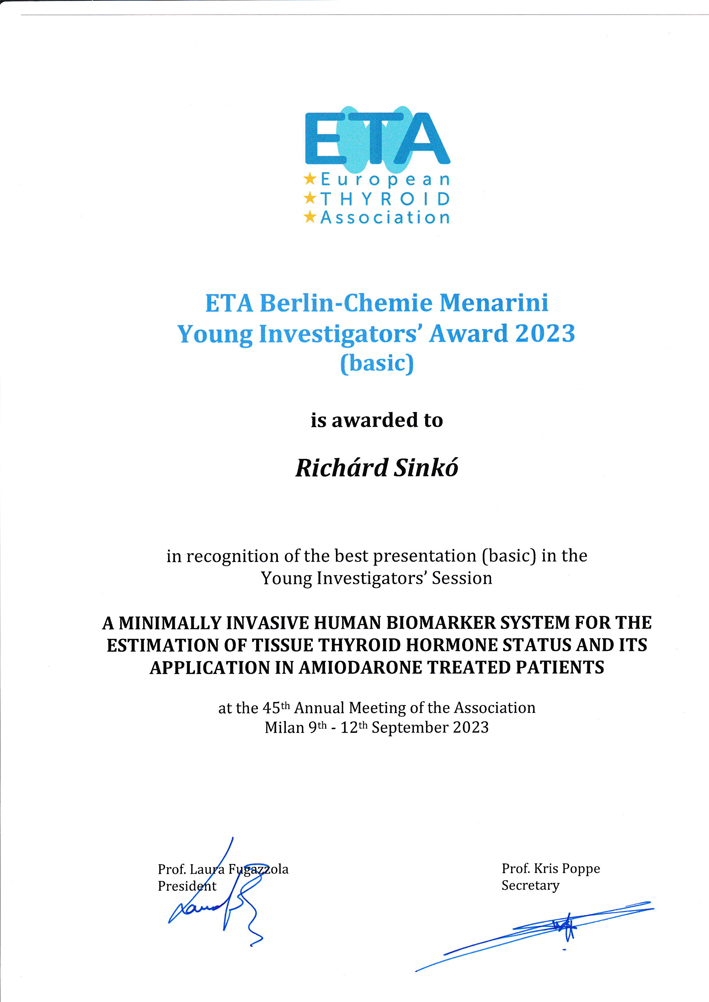A prize from Milan
Richárd Sinkó, PhD student and member of the Molecular Cell Metabolism Group, has won the Berlin-Chemie Menarini Young Investigators' Award for researchers under 35 years of age in the basic research category at the ETA 2023 conference in Milan.
Italy has been a top tourist destination for at least two hundred years. A man should be on his feet who has something new and original to say about its most famous cities. If Florence, then Italian Renaissance, all roads lead to Rome, Naples is to see, though preferably not to die for.
But let's talk about Milan, which is closer to us, its dialect is not as melodious as Tuscan, but it is more suited to the capital of Lombardy, which is a financial center because of its international stock exchange. Many people know from experience that it is one of the most expensive cities in Europe, others visit it because it is an international center of fashion and design. The world's first luxury shopping center, named after Italy's first king, Victor Emmanuel II, opened here in 1877.
From the Galleria Vittorio Emanuele II you can exit in one direction into a rather spacious square, where the main attraction is not the imposing equestrian statue of the aforementioned monarch, but the Duomo di Milano, a pale pink-white marble building, built in 1396 until the end of the 20th century, with various interruptions, and redesigned several times, with the features of perhaps every architectural style since the Gothic period, rather wide than wide stone-chip wonder, the second-largest church in Italy and the fifth-largest in the world. On the cupola tower stands a gold-plated statue of Mary, small only when seen from the ground, actually 4.16 m high, which Milanese call Madonna (Madunnina). Since the statue was added to the dome of the Duomo in 1762, no building taller than the Madonnina's star-wreathed head has been allowed in Milan. The rule is observed, albeit in Milanese fashion. They don't have skyscrapers, but by 2015, three of their buildings were much taller than the Duomo. However, the Madonnina, although smaller than the original, is on top of all three.
A street away from the other exit of this magnificent and elegant shopping gallery is the Scala di Milano, which is known not for its appearance. For music lovers, especially opera lovers, it's one of the centers of the world; for those who prefer the fine arts, walk in the opposite direction and, if you've bought tickets online, you can see Leonardo da Vinci's bombed-out fresco of The Last Supper in the refectory of the convent next to the church of Santa Maria delle Grazie, designed by Bramante.
The list of sights could go on, but I don't think that Richárd Sinkó PhD student, a member of the Molecular Cell Metabolism Group led by Balázs Gereben, who recently returned from Milan, could have visited even one of the sights described in the dog's pile above. Richard (Ricsi) was not visiting the city, but attending a conference, and scientific conferences are not usually held near the Duomo square.
He did, however, bring back something of value, if not from the famous Gallery. He won the Berlin-Chemie Menarini Young Investigators' Award for researchers under 35 in the basic research category.
But let him tell the story!
"ETA, the European Thyroid Association, was founded in 1965 with the aim of promoting clinical and basic research to improve the understanding of thyroid disease and the quality of clinical practice. Its annual conferences are popular with colleagues from both the Far East and overseas. This year's meeting in Milan was the 45th.
The society, which has a membership of around 1,000, takes special care to support the next generation of clinicians and researchers. It has for many years been promoting the participation of young people in conferences by organizing a Young Investigators' Section, with separate categories for clinical, translational, and basic science. The two parallel sections will be open to candidates selected by the society from among those who submit an abstract and present their results in 15+5 minute papers. Although this is a competition, there are no real losers. The discussion is conducted in a positive and constructive atmosphere, and the selection for the presentation is a recognition in itself. The evaluation will take into account the material submitted, i.e. the results, as well as the performance itself, the performance of the performer. The winner in each of the two categories will be awarded the Berlin-Chemie Menarini Young Investigators' Award, founded by one of the company's sponsoring companies.
- How did you win?
- I entered the basic science section and presented a paper that was entirely home-grown. The work started before COVID-19 and is the result of collaboration with several clinical partners.
Our group is investigating molecular aspects of the thyroid hormone (PMH) household, with a particular focus on its neurological implications. This requires the quantification of the tissue PMH effect, which is a major professional challenge. To overcome this challenge, the research team developed years ago a mouse model called the THAI (Thyroid Hormone Action Indicator) mouse (sometimes referred to in the press as the "glowing mouse"). The mouse tissues produce luciferase as a marker, the amount of which can be measured and is proportional to the strength of the tissue PMH effect. The animal model has been used to elucidate several tissue mechanisms of PMH homeostasis, such as T3 in some aspects of neuronal transport of activated PMH.
However, there is also a growing need to measure tissue PMH effects in humans. This is because in some patients, the results obtained by routine diagnostics, measured circulating hormone levels, and other evidence, such as symptom severity, are inconsistent. To resolve these discrepancies in a scientifically proven way would require measurement of tissue PMH signaling, which has not yet been done. In my presentation at the conference, I presented a new method that could complement routine diagnostics by serving this purpose.
- Given the background, this is also a good result and I wish it could be introduced into clinical practice as soon as possible! How did it work, what was your starting point?
- It may sound shocking, but it required the hair follicles of hundreds of human participants. We used the hair follicles to identify PMH-sensitive markers/signaling substances and used these to characterize tissue signaling in patients, knowledge of which could help medical decision-making in many patients. Our method was first applied to samples of patients treated with amiodarone. Indeed, potential side effects of this cardiac drug include alterations in the PMH household, with a drastically elevated PMH level (hyperthyroidism) affecting a proportion of patients being of particular importance.
However, it is interesting to note that in most cases the hyperthyroidism that develops is only mild, which is a strong contradiction, and it is suspected that the patients concerned do not develop tissue hyperthyroidism.
In the paper presented here, I have presented our results supporting this hypothesis in human samples, which were confirmed by our results in the THAI mouse model.
- What was the response - apart from the prize, which I am not surprised you were awarded after all!
- A lively discussion followed the presentation, and both scientists and clinicians came up to me after the session with enthusiastic appreciation.
- When will the presented material be published as an article?
- A publication addressing the part of our complex and wide-ranging work presented at the conference is in preparation.
- Do you see a good chance that the method will be incorporated into clinical practice?
- We have also worked to develop a method that is easily adaptable to medical practice and, of course, we have also kept in mind the economic potential, such as a patent.
- You will certainly benefit from the experience gained with the THAI mouse to obtain a patent!
- We already know how complex the patent process is for the THAI mouse. We also need the support of our clinical partners, because we need to know the needs and perspectives of users to further develop the methodology.
- You received the award and your presentation certainly contributed a lot to the recognition of your work. But in a successful research project, there are always more people involved!
- This was of course the case again. In addition to the members of our research team, the contribution of our clinical partners was also very much needed for the successful outcome, and we would like to thank them for their enthusiasm and help, as well as all the sample donors for their participation.
Special thanks to the KOKI staff who donated their blood and hair follicles for this research!





